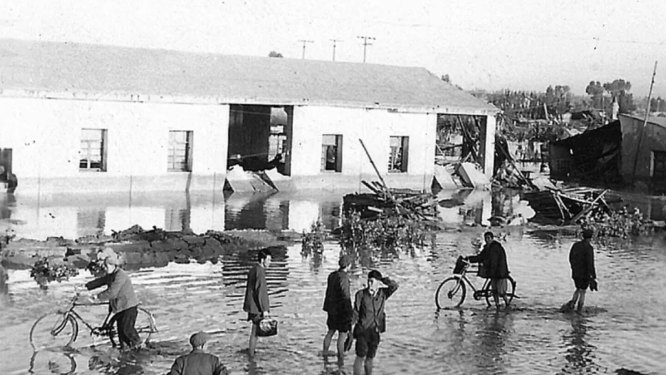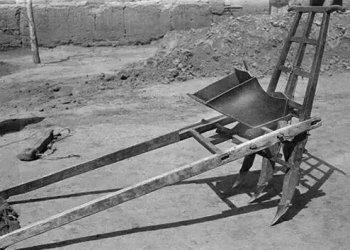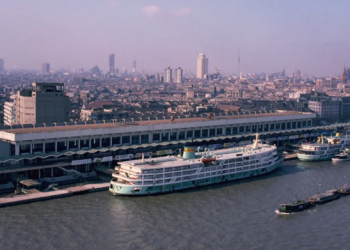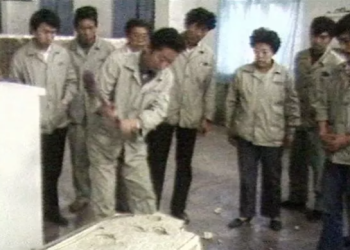In 1979, the weather seemed to break free from its usual constraints, falling into an abnormal vortex. Temperatures in Dunhuang soared relentlessly, unbearable heat sweeping across the land. The scorching sunlight relentlessly baked the earth, a heatwave that even reached the snow-covered Qilian Mountains. Under the heat, the thick snow on Qilian Mountain began to melt, like ice dissipating under the sun. The snowmelt quickly gathered into torrents, rushing down like wild stallions, carrying with them immense power. As July progressed, the water levels in the reservoirs upstream of the Danghe River rose rapidly under the impact of the melting snow. The situation became more alarming as the water surged, soon filling the entire reservoir.

But this was only the prelude to disaster, as even more startling events were quietly brewing. The Southwest Monsoon from the Indian Ocean, which typically follows a fixed path, behaved erratically that year. Normally, it would head southeast, but this time, like a lost traveler, the monsoon split into two routes, one of which unexpectedly veered north toward the Qilian Mountains. Laden with warm, moist air, this monsoon behaved like a “generous giver,” continuously supplying Dunhuang with abundant rainfall. The rainfall was unusually concentrated and intense. In 1979, the total annual precipitation in Dunhuang skyrocketed to 105.5 millimeters—three to four times the usual amount. The concentrated rainfall caused the Danghe River reservoir to rise sharply. The water level surged like a rocket, quickly crossing the danger line, and soon, the entire region was under threat.
On July 26, under the relentless assault of heavy rain, the water level in the Danghe River reservoir continued to climb without restraint. The long period of high water pressure gradually took its toll on the dam, and eventually, the secondary dam failed. With a deafening roar, the floodwaters, which had been contained in the reservoir, were released, surging forth like untamed wild horses. This flood, like a vengeful demon, turned what was once a vital irrigation system into the very source of a catastrophic disaster.

At 1:30 AM on July 27, the flood, carried by dry channels and the Danghe River waterway, came crashing down toward Dunhuang’s county seat with immense force. In the blink of an eye, the entire county was engulfed by the terrifying floodwaters. In the darkness, the roar of the floodwaters, the creaking of collapsing houses, and the cries of the people created a sorrowful symphony, a tragic human song.
As the flood raged, it swept everything in its path, leaving behind destruction and chaos. At the heart of the county, where the large roundabout is now located, several old wooden cabinets were helplessly swept away by the floodwaters, floating like silent witnesses to this human tragedy. As the floodwaters rushed down Yangguan West Road, the once-bustling shops, grain depots storing food reserves, and tightly packed residential buildings were reduced to rubble under the overwhelming impact of the flood. Streets that once thrived with life were instantly transformed into a waterlogged wasteland. Many residents, suddenly awoken from their sleep, scrambled to escape the approaching flood. Those unable to flee in time saw their possessions swept away by the floodwaters.

The residents who had been awoken in panic were helpless in the face of the flood, searching for a way to escape in the dark and the water. They could only watch in horror as their homes, built through years of hard work, were gradually consumed by the flood’s fury. The County Party Committee office also fell victim to the flood, thrown into chaos, with documents scattered all over the place and office equipment overturned. In this disaster, the Danghe River Bridge, a crucial link between the two banks of the city, was also destroyed for the eighth time by floodwaters. Since the nineteenth year of Daoguang (1839), the bridge had been repeatedly swept away by floods. Each time it was destroyed, it caused great inconvenience to the residents of both banks. The 1979 flood, once again, brought this weathered bridge to the ground, further complicating the city’s already chaotic situation. The entire county seemed to be isolated in a vast sea, cut off from the outside world.
When the floodwaters finally receded, Dunhuang was left in ruins. A week after the disaster, the Qinghai Oilfield sprang into action, transporting cement and other materials from over 500 kilometers away from Huatugou to the West Bridge, offering vital support for the subsequent rebuilding efforts. However, the path to recovery was filled with hardship and challenges. Many homes had to be rebuilt, and essential infrastructure had to be repaired. For both the local government and the citizens, this was not just a material rebuilding process—it was also a journey of spiritual recovery.

According to post-disaster statistics, in the county area alone, 4,815 houses were destroyed, and 7,279 people were affected, accounting for 7% of the county’s population at the time. The economic loss reached approximately 35.25 million yuan. Once a bustling and lively county, Dunhuang had been reduced to a wasteland in the blink of an eye. Everywhere you looked, there were broken walls, scattered belongings soaked in water, and the lives of the people were utterly disrupted, plunging them into despair and helplessness.

However, despite the heavy blow, the resilient people of Dunhuang did not succumb to the disaster. The local government acted quickly, organizing all available forces to initiate rescue operations. They worked tirelessly to help the affected citizens settle into temporary shelters, distribute disaster relief supplies, and ensure the victims had food to eat and clothes to wear. Medical teams also swiftly arrived to provide timely medical assistance to the injured, helping to alleviate the physical pain caused by the flood. Government workers patiently comforted the anxious residents, offering emotional support and encouragement.
In the long days that followed, the people of Dunhuang, united and determined, threw themselves wholeheartedly into the monumental task of rebuilding their homes. They faced the challenges with bravery, tools in hand, clearing away the rubble, and rebuilding the collapsed homes and broken items. Then, in an orderly fashion, they began repairing houses, each brick and tile symbolizing their love for their homeland and their determination to restore it. Meanwhile, relevant departments re-planned the city’s infrastructure, reinforced water conservancy facilities, and improved the drainage system, aiming to make this ancient city more resilient to future natural disasters, allowing it to thrive again in the years to come.
The 1979 Dunhuang flood, though it brought immense and indelible devastation to the city, also revealed the great spirit of the people of Dunhuang, who, in the face of disaster, fought with unyielding determination. This flood has since become a deeply etched memory in the history of Dunhuang, always serving as a reminder to respect nature, value the construction and maintenance of water conservancy infrastructure, and continuously improve the ability to cope with natural disasters. It reminds us all to prevent similar tragedies from occurring again, so that the land of Dunhuang can remain peaceful and harmonious for generations to come.











